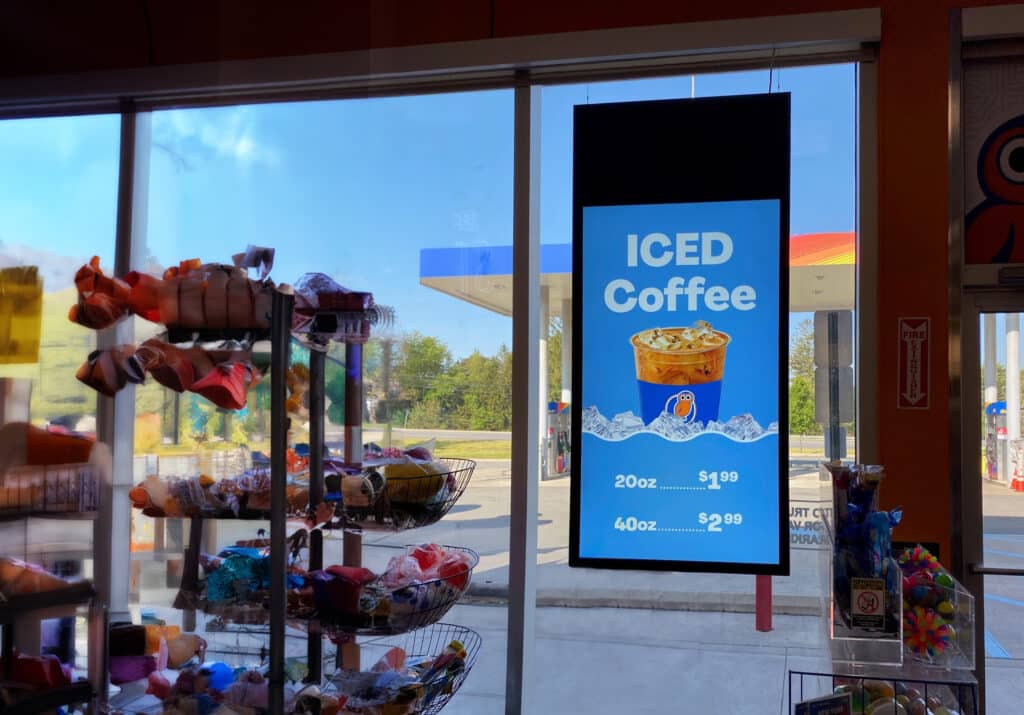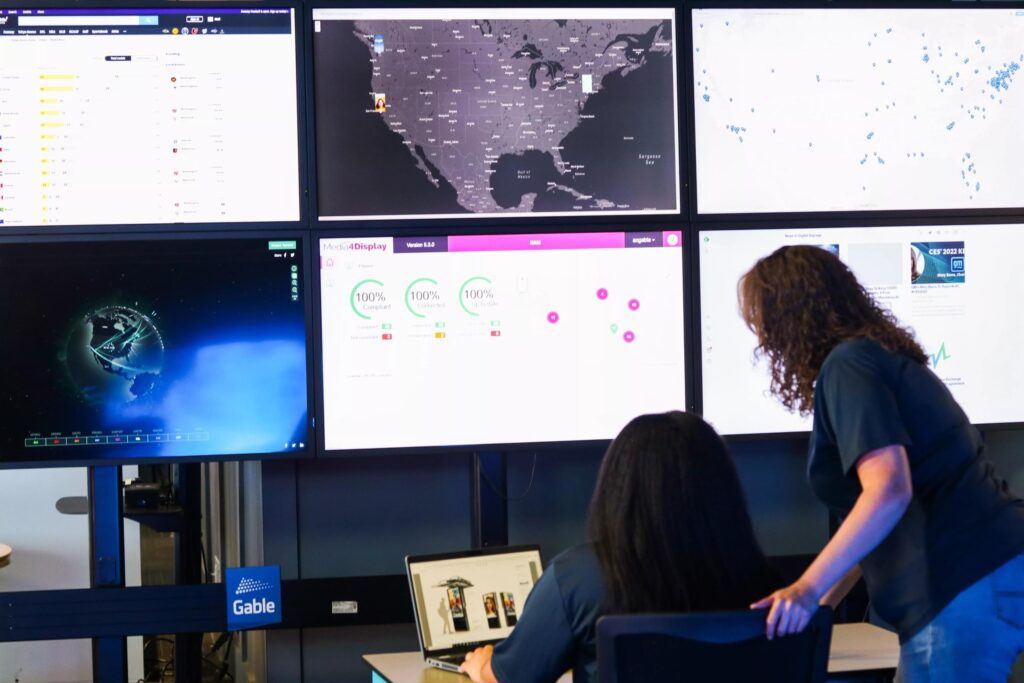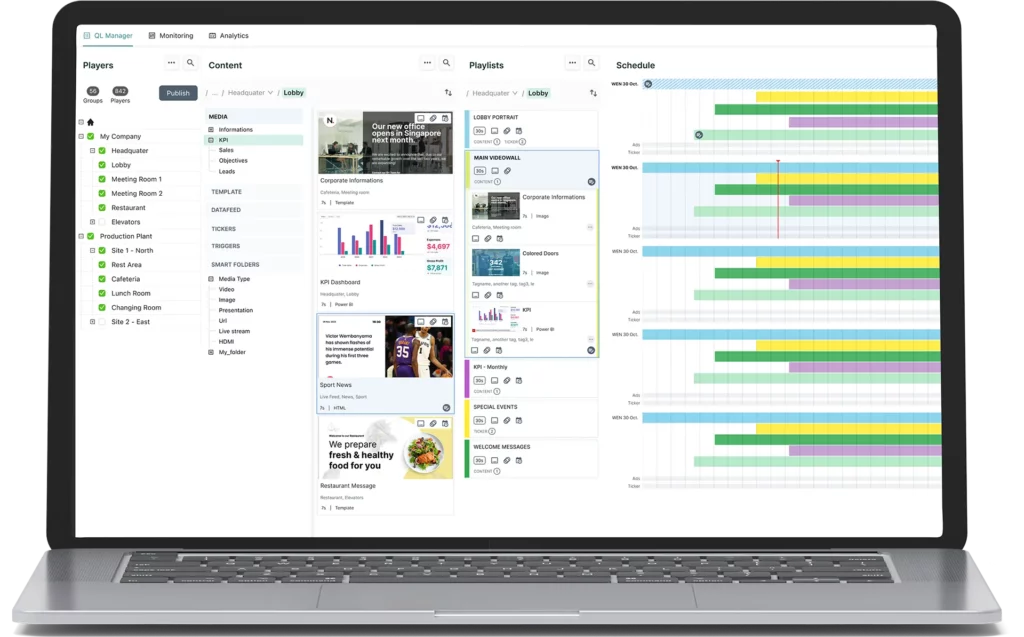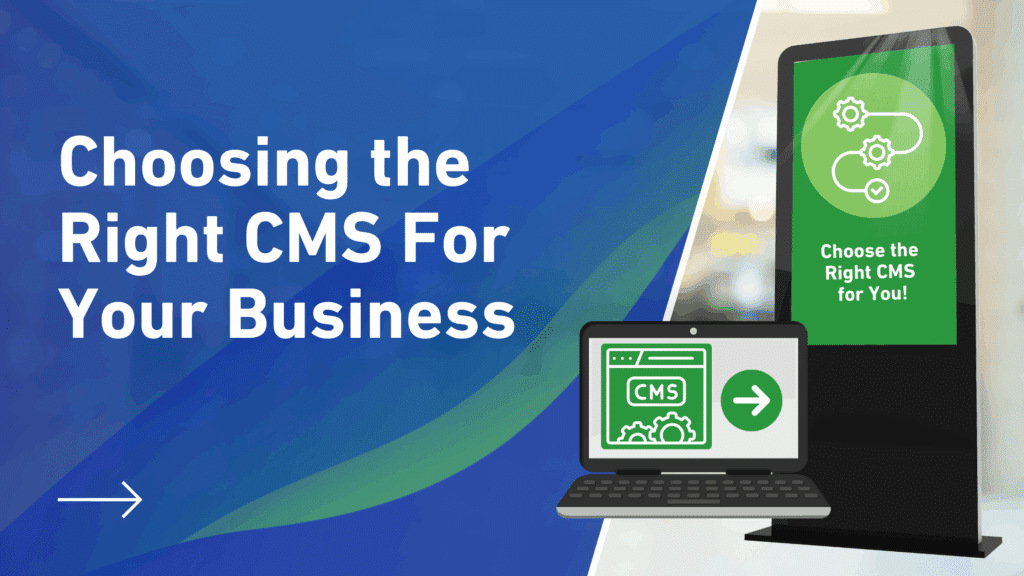In simple terms, a Content Management System (CMS) is the central brain of your digital signage network. It lets you create, schedule, and control content across screens from a single dashboard.
Whether you’re managing restaurant menu boards, interactive mall kiosks, or a nationwide Retail Media Network, the right CMS ensures your message appears at the right place and time, with minimal fuss. But with countless platforms available, how do you choose the one that aligns with your business goals and technical needs?
In this blog post, we break down key CMS solutions for digital signage, wayfinding, and network management, and help you find the support you need to implement them successfully. We’ve also created a comparison guide to help get you started.
Find Which Content Management Systems Align With Your Business Goals
Digital signage is a powerful medium for communication, but its effectiveness depends largely on the quality of the content it displays.
Digital signage isn’t just about pretty screens; it’s about achieving business outcomes. Before diving into specific platforms, clarify what you need your signage CMS to accomplish. Common goals include:
Centralized Content Control

With a good CMS, you can update and deploy content to all your displays remotely, eliminating the need for manual on-site updates. It serves as a central hub where you can upload images, videos, and set alerts, ensuring your messaging stays consistent across all locations. This also makes it easy to launch time-sensitive campaigns such as flash sales or urgent announcements.
Dynamic Scheduling and Dayparting
Beyond simple playlists, you may want to schedule content based on time of day, day of week, or specific triggers. For example, a cafe might show breakfast menus in the morning and switch automatically to lunch menus at 11:30 AM.
Advanced scheduling features such as recurring playlists, defined start and end dates, and conditional playback using tags or rules ensure the right content plays at the right time.
This is especially crucial if you operate across multiple time zones or run promotions that need to start and stop on precise dates.

Scalability and Network Management
As your screen network grows from a small pilot to hundreds of displays, your CMS should be able to grow with you. Look for cloud-based systems that make it easy to manage many devices and locations from one interface. Scalable content management systems let you group displays to target content by region or store type and set user permission levels if your team has multiple contributors. In short, the right CMS won’t be the bottleneck as you expand.
Integration with Data and Systems
To create truly dynamic, context-aware signage, integration is key. You might want your displays to show live data such as news feeds, weather, social media, inventory levels, or even tailored content triggered by sensors. Many modern content management systems offer APIs or built-in tools to pull in external data, making it possible to show things like local weather forecasts or the number of available parking spots.

If you’re planning interactive experiences, integration with sensors or touchscreens allows content to respond in real time. For example, a kiosk can change its content when a customer taps the screen or when a motion sensor detects someone nearby. The goal is to ensure your CMS can “talk to” other enterprise systems rather than being a standalone silo.
Performance Analytics
Just like web analytics for your website, analytics in digital signage tell you if your content is effective. Robust content management systems can track playback data, proof-of-display logs, and even viewer engagement in some cases. For Retail Media Networks, you’ll want reports on ad play counts and durations for each screen.
Some CMS solutions integrate with audience analytics, such as using camera sensors or lift-and-learn triggers to gauge engagement and trigger content. On such system, Navori, offers audience measurement add-ons and rule-based playback based on real-time conditions.
At minimum, ensure your CMS provides dashboards or exportable logs to help measure ROI, showing which content ran, when, how often, and perhaps even which messages led to more customer interaction. These data-driven insights allow you to continually refine your strategy.
By pinning down these goals, you create a requirements checklist to evaluate potential content management systems. Now, let’s explore a few of our favorite platforms and where each tends to excel.
Exploring Leading Content Management Systems and What They Offer
Navori Software | Enterprise-Grade Flexibility and Features

Where Navori stands out is in its support for dynamic, data-driven content through a variety of powerful integrations. The platform connects with a wide range of data feeds, including social media, calendars, weather, and real-time analytics for audience-triggered playback, allowing content to be automated based on inventory levels, demographics, or external triggers. Additionally, it integrates with Adobe Experience Manager (AEM) Assets, streamlining digital content and asset management across multiple channels. Navori software also offers programmatic advertising capabilities for retail media networks, enabling real-time campaign adjustments based on audience engagement, maximizing ad revenue opportunities.
It’s highly scalable, hardware-flexible, and SOC 2 Type II compliant, working across varying operating systems such as Windows, Android, and smart displays from brands like Samsung and LG. This makes it a strong choice for large networks where both central control and local flexibility are important.
With its powerful web interface, expert setup, and the scalability required for enterprise deployments, Navori software is the ideal long-term solution for companies needing custom integrations, granular control, and proven reliability.
BrightSign | Hardware-Driven Reliability and Flexibility
BrightSign is a trusted name in digital signage, known for its purpose-built media players that deliver high reliability in always-on environments. Unlike software-first platforms, BrightSign is hardware-centric, with content running on their rugged players and managed through BrightSign’s own CMS, brightAuthor connected, or a wide range of compatible third-party systems.
This hardware-software synergy is ideal for networks that demand stability and uptime. BrightSign devices are built for 24/7 playback, with built-in fail-safes that keep screens running smoothly. Updates can be deployed remotely and quickly, making it easy to manage content across multiple locations without on-site visits, which is especially valuable for retailers or QSRs with frequent promotions or menu changes.
Beyond stability, BrightSign stands out in interactive settings. Its media players support touchscreens, RFID, motion sensors, and more, allowing displays to respond to real-world interactions. This makes them a great fit for kiosks, exhibits, and retail environments.
Another key strength is flexibility. You’re not locked into BrightSign’s CMS, meaning you can switch to a different system later without replacing the hardware. The players also handle 4K video, HTML5, and live content with ease, delivering strong performance.
In short, BrightSign is a top choice when you need bulletproof reliability, remote scalability, and interactive capabilities. It’s especially well-suited for retail chains, corporate networks, and other multi-site deployments where downtime is not an option.
VNNOX | Cloud Control for LED Displays Made Simple
VNNOX is NovaStar’s cloud-based platform built for managing LED displays like video walls and outdoor billboards. It offers centralized, remote control so you can monitor and update screens from anywhere. Whether managing one display or hundreds, VNNOX lets you publish content and adjust schedules quickly and securely through a web interface.
Its strengths lie in simplicity, reliability, and tight integration with NovaStar hardware. You can easily schedule images, videos, and text playlists, making it ideal for routine signage like menu boards or promotional loops.
VNNOX focuses on content distribution and monitoring, not advanced features like touch interactivity or complex layouts. But for businesses needing a lightweight, dependable way to keep LED screens up to date without the extra complexity, VNNOX is a solid, go-to solution.
Acquire | Purpose-Built for Interactive Wayfinding and Kiosks
Acquire specializes in creating interactive digital experiences, making it ideal for wayfinding, self-service kiosks, and high-engagement displays. It combines a robust CMS with content creation tools, allowing you to design and manage dynamic, touch-enabled interfaces across a network of screens.
Well-known for powering wayfinding in major venues, Acquire handles complex content with ease. It supports everything from 2D and 3D maps to multi-zone layouts and real-time data integration such as live flight information or store promotions. Its playback engine supports ultra-high-resolution video, overlays, and multi-screen synchronization, making it suitable for visually rich environments.
Common use cases include interactive mall directories, custom maps, or retail kiosks where users explore products or services. The platform is extensible, with built-in widgets and scripting options for custom functionality. While it requires more upfront setup than a basic signage CMS, the trade-off is a fully tailored, interactive experience.
Acquire is a go-to choice when your goal goes beyond passive content to active engagement, turning kiosks into digital concierges and wayfinding into an intuitive, branded journey. It is especially valuable in busy environments like airports, hospitals, or large venues where reliability and user experience matter most.
Matching the Right CMS Solution to Your Needs
As we’ve seen, each Content Management System has its sweet spot. The reality is that choosing the right CMS is less about picking a “winner” and more about finding the best fit for your specific objectives.
Here are a few final considerations to guide your decision:
Start with Your Goals: Always circle back to what you need to accomplish. Are you primarily pushing marketing content to a simple network of screens? Or are you crafting interactive journeys and data-driven campaigns? A clear vision of use cases will narrow your options quickly
Consider the User Experience: Think about how both your audience and your content managers will use your CMS. A system might offer many features, but will your team actually use them? If you lack a dedicated technical staff, a user-friendly CMS with strong training and support is essential. On the other hand, if you hire Gable’s designers or have your own innovation team aiming to do cutting-edge work, you’ll want a platform that does not limit creativity.
Total Cost of Ownership: Factor in not just licensing costs but also hardware, deployment, and maintenance. Comprehensive content management systems might involve higher software fees or development effort, but they could replace multiple systems by handling many tasks in one. Balance your budget against the ROI each platform’s capabilities will deliver. Sometimes a higher-end CMS pays for itself by enabling new revenue streams like advertising or reducing labor costs through automation.
Scalability and Futureproofing: Think long term. If you plan to scale, choose a solution proven at that scale. Also, consider future needs, such as incorporating programmatic advertising or audience analytics down the road. Ensure your chosen platform can integrate with ad servers or at least provide proof-of-play data if monetization is a goal. Being future-focused means picking a CMS that can evolve, either through updates or integration, as the digital signage landscape advances.
Trial and Expert Guidance: Whenever possible, do a pilot or demo with your short-listed systems. It’s one thing to read about features; it’s another to see them in action with your content. And don’t underestimate the value of expert guidance. Our team often conducts needs assessments where we identify the best CMS (or combination of tools) for a client’s scenario. A consultative approach can save a lot of trial-and-error in implementation.
Ready to elevate your digital signage content? Reach out to Gable’s knowledgeable digital solutions team at 800-854-0568 or schedule a free consultation to explore the best design tools and strategies for your needs. Together, we can turn your vision into a captivating digital experience that shines.

Get Our Free CMS Comparison Guide
About Gable
Gable has been a leader in visual communications for over 45 years. We are passionate about elevating how people perceive, interact with, and remember brands, buildings, and places. With a rich legacy in blending the timeless artistry of traditional signs with the dynamic possibilities of video displays & integrated AV systems, Gable continues to shape the future of the built environment. For more information, visit gablecompany.com or call 800-854-0568.






